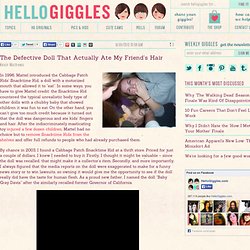

Why toys are more divided by gender than ever before. Abi Bechtel, a mother of three, was shopping at Target two years ago when she spotted a sign in a toy aisle that advertised “building sets,” and, separately, “girls’ building sets.”

Bechtel rolled her eyes, took a photo and posted it on Twitter. “Don’t do this, Target,” wrote Bechtel, an Ohio university instructor. Two months and 3,000 retweets later, Target responded to the swell of customer criticism with a promise that its stores would begin phasing out signs that categorize toys by gender. The 2015 move was applauded by researchers and parents concerned that labelling toys for “girls” or “boys” reinforces harmful gender stereotypes. But a backlash soon erupted on social media, with some customers decrying “political correctness” and fearing the world was headed toward “the end of boys and girls.” Here, let this wise 8-year-old tell you why gendered clothing is the worst. Sure, some kids may say the darndest things — but sometimes they say what we've all been thinking.

In a video that has now gone viral with more than 1 million views, 8-year-old Daisy Edmonds is seen walking around the U.K. chain Tesco with a mission: To call out the sexism behind the T-shirts that are sold to girls like her. "What do you think of the clothes on offer today? " Why doll make-unders make me uncomfortable. In various corners of the internet, a trend has been building: doll make-unders.

Have you seen these? I’m particularly interested in the re-making of a particular kind of doll: the Bratz doll. Back in January, the work of Tasmanian artist Sonia Singh was making the rounds. She takes discarded dolls and redoes their faces and makes them new clothing, making them “ready for outdoor adventures.” What NOT to do if your son's soccer team gets PINK uniforms. Dear parents who totally suck and should be ashamed of themselves, Yeah, I heard about what you did.

One of my readers sent me an email telling me allllll about it, and I am mortified by your behavior. Seriously, un-flippin’-believable. But I’m not a total jerkwad and I know there are two sides to every story, so let me just make sure I understand your whole situation. Everybody in dresses: Why does gender neutral clothing always mean ‘boy’ clothes for girls? When I was working as an ASL interpreter in a high school in rural Nova Scotia, the English teacher announced one day that the class was going to read The Outsiders.

The kids groaned as he handed out the battered paperbacks. Having found the book dated when I read it in my own grade ten English class years earlier, I sympathized with their reactions. But the teacher was determined to secure everyone’s enthusiasm for the plight of the Greasers. Toys Are More Divided by Gender Now Than They Were 50 Years Ago. When it comes to buying gifts for children, everything is color-coded: Rigid boundaries segregate brawny blue action figures from pretty pink princesses, and most assume that this is how it’s always been.

But in fact, the princess role that’s ubiquitous in girls’ toys today was exceedingly rare prior to the 1990s—and the marketing of toys is more gendered now than even 50 years ago, when gender discrimination and sexism were the norm. In my research on toy advertisements, I found that even when gendered marketing was most pronounced in the 20th century, roughly half of toys were still being advertised in a gender-neutral manner. This is a stark difference from what we see today, as businesses categorize toys in a way that more narrowly forces kids into boxes. L’humoriste ne peut se soustraire à la critique. Childhood Gender Roles in Adult Life - Gender Mystique. Document d'accompagnement « Les livres et les jouets ont-ils un sexe? Children don't want sexist pink and blue toys. This week, a seven-year-old girl called Charlotte Benjamin wrote a heartfelt, straight-to-the-point letter to Lego asking it to rectify the fact that there are "more Lego boy people and barely any Lego girls".

She also pointed out that "all the girls did was sit at home, go to the beach, and shop, and they had no jobs, but the boys went on adventures, worked, saved people … even swam with sharks". She also swiftly and succinctly expressed her displeasure at the illogical and old-fashioned use of pink and blue marketing to separate Lego into boys' and girls' sections. In brief, she nailed it. 24 Badass Halloween Costumes To Empower Little Girls.
Télé et cinéma. Garçon -vs- filles. Filles. Barbie. Princesses. Garçons. Rose et bleu. LEGO. Sexy. The Defective Doll That Actually Ate My Friend’s Hair. In 1996, Mattel introduced the Cabbage Patch Kids’ Snacktime Kid, a doll with a motorized mouth that allowed it to “eat”.

In some ways, you have to give Mattel credit: the Snacktime Kid countered the typical unrealistic body type of other dolls with a chubby baby that showed children it was fun to eat. On the other hand, you can’t give too much credit because it turned out that the doll was dangerous and ate kids’ fingers and hair. After the indiscriminately masticating toy injured a few dozen children, Mattel had no choice but to remove Snacktime Kids from the shelves and offer full refunds to people who had already purchased them. By chance in 2003, I found a Cabbage Patch Snacktime Kid at a thrift store. Priced for just a couple of dollars, I knew I needed to buy it.